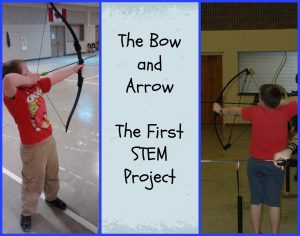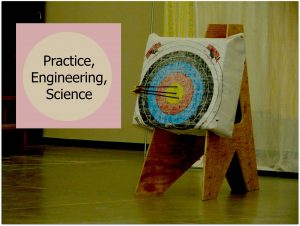STEM Project: The Bow and Arrow
Lately on Pinterest I am seeing a lot of information about STEM or STEAM projects. I have to admit that they look like fascinating projects — that combination of the disciplines of Science, Technology, Engineering, and Mathematics (sometimes adding Art). So fascinating indeed that I plan to do a day of STEM projects with my homeschool group. In the process of looking for projects I came upon a couple of bow and arrow projects … this, of course, made me ponder … how is a bow and arrow an engineering project? Isn’t it primarily a tool used for hunting?
So I turned to a handy engineering book I have (The Engineering Book by Marshall Brain), therein I learned that the bow and arrow was the first engineered tool. Isn’t that amazing? The common bow and arrow has been around for ages and ages.

When you stop to think about it, you have to admit that the bow and arrow is one fine piece of engineering. My son and I recently read a story about two groups that were fighting each other and the one group lost primarily because their bow and arrows did not have the reach that the other group did. The other group could do more damage from further away, thereby preventing the devastating advance that the other group would have otherwise employed. They simply could not get close enough to use their most potent weaponry. Same tool, just engineered differently.
Consider what engineering facts you can learn from the bow and arrow:
- Stored energy
- Projectile weapon
- Fashioned from objects readily found in nature
- Wood plus string equals stored energy
- Add bone or stone to the projectile for mass, add feathers for stability
It’s all a STEM project and some folks make them fancy or shine them up and suddenly its a STEAM project!

So, how does the bow and arrow impact us as homeschoolers?
- Physical Education. My son LOVES archery. He’ll do it as often as he can, wherever he can. You can’t just shoot arrows, you also have to build up the muscles needed to shoot the bow well. You need to understand a bit about the human body to know which muscles to build up and how they work together to maximize your efforts.
- Engineering and Technology. Why does a recurve bow shoot differently than a compound bow? The placement and type of feathers used and the direction the off-coloured arrow points – why does it all matter? Does it matter if it’s all wood or made from composite materials? The weight of the bow, the weight of the arrows … how does one determine what will suit best?
- Commitment. To do well in archery you need to keep practicing. You need to harden your fingers to the bow string (and/or use finger protection). You need to practice shooting at the target so you can clump your arrows.
- Finances. Good equipment costs money. It’s also good to have arm-guards, lessons, finger protection, and arrows (because they do break or need new tips).
Annette Vellenga is Loved by God and family – these things center me. She is a Writer, Poet, Hiker, Reader – these things make me smile. She does Educating, Raising a child, Involved with Critters – These things make me grow. She can be found at A Net in Time.














































